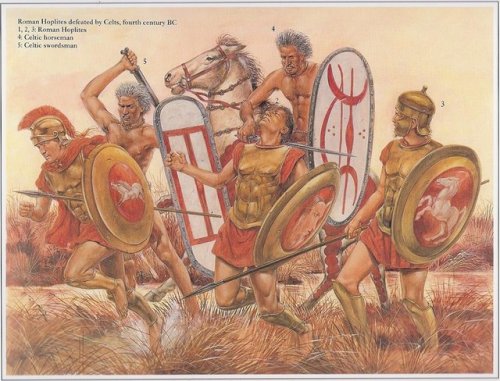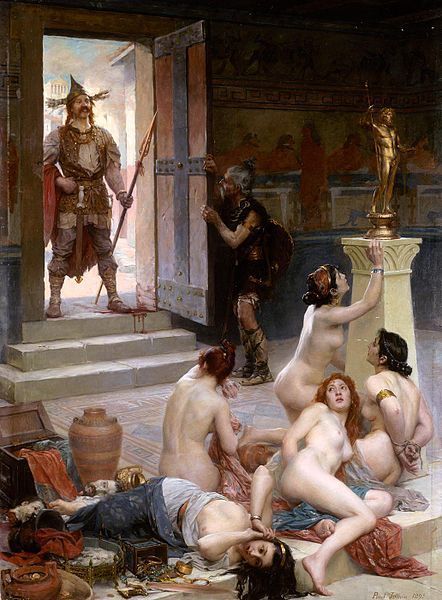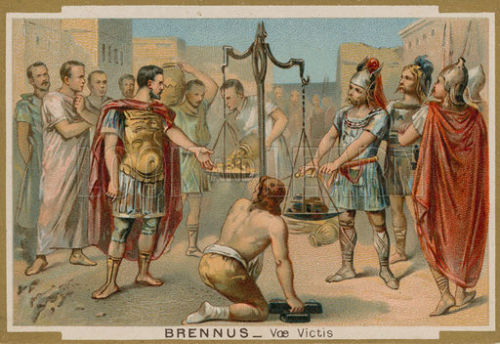peashooter85:The First Sack of Rome, 390 BCThroughout history Rome was sacked many times by invaders
peashooter85:The First Sack of Rome, 390 BCThroughout history Rome was sacked many times by invaders, perhaps the most popular sackings being in 410 AD by the Visigoths and in 455 AD by the Vandals. Both sackings symbolized the fall of the Roman Empire. however the very first sack of Rome occurred early in Roman history, and symbolized the birth of the empire. The first sack of Rome supposedly occurred in 390 BC, although the date varies a bit from source to source and dating system. At the time Rome was a mere city state, it’s borders no larger than a 30 km radius from the city of Rome itself. It was then that Rome earned the ire of a Gallic/Celtic tribe called the Senones, who were led by a king named Brennus. The Senones had earlier invaded Northern Italy and settled the Adriatic coast. In 390 they attacked the Etruscan town of Clusium, Clusium appealed to Rome for help, and the Romans sent three ambassadors to the Senones to warn them that they would defend the town. During the negotiations, a fight broke out and one of the Roman ambassadors murdered a Senones ambassador. In order to exact revenge, the Senones gathered their army and marched on Rome.The Roman and Gallic armies met at the Allia River, about 16 km north of Rome. Exact numbers are very fuzzy, with the Romans having around 20,000 - 40,000 soldiers and the Senones having around 12,000. Other sources say that the Romans had much more men while the Senones army was a gigantic raging hoard as large as 70,000. However, it is most likely that the forces involved were much smaller, and that the Roman’s greatly outnumbered the Senones. Despite having a numerical advantage, the Roman Army of the early republic was not the highly skilled, heavily trained Roman Army of the later republic and empire. It was a small citizen militia force, poorly trained, poorly equipped, while using simple tactics. Soldiers were required to provide for their own weapons, armor, supplies, and training, thus wealthier Roman citizens were better armed, while poorer citizens were lightly armed. The Romans were arrayed with their heavy infantry in the center, consisting of 2-4 legions in phalanx formation. Guarding their flanks were light infantry, consisting of the poorer Romans who had lesser quality weapons and less training. At the rear was a reserve force of light infantry on a fortified hill, which was to counterattack if the Roman flanks collapsed. At the outset, the Gauls attacked the Roman flanks. The Celtic Senones were alien to the Romans, with their long hair and tall muscular physiques making an intimidating sight. Rather than fight, the Roman light infantry forces at the flanks fled in terror while the reserve force was easily crushed. The more experienced Roman heavy infantry bravely held their ground but being outflanked and surrounded was quickly annihilated. The Romans who survived the battle fled to Veii, a nearby city which had been recently conquered by Rome, or took up a fortified position on the Capitoline Hill.The Senones stormed Rome and looted the city. Most of the Roman population scattered to the countryside while those who could take up arms occupied a fortress on the Capitoline Hill. Roman Senators who could neither take up arms or lead troops in battle stoically sat in front of their estates, wearing their ceremonial garb, waiting for the Gauls to arrive and kill them. The Senones were unable to take the hill, and thus settled down to besiege the remaining Romans. After several months famine began to take hold. Finally both sides agreed to a deal in which the Romans would pay 1,000 lbs of gold if the Senones withdrew from the city. During the weighing ceremony the Senones supposedly rigged the scales to their favor. When the Roman’s called out the Senones for cheating, Brennus took off his sword and dropped it on the scales exclaiming, “woe to the vanquished.”According to Roman historians before the gold could be exchanged a massive Roman army led by the hero Camillus arrived just in time and destroyed the Senones army, saving the day. Most likely this part of the story didn’t happen, rather being a piece of Roman propaganda added after the fact in order to save face. I would more likely believe stories that the Celts rode unicorns into battle and that Brennus was a Decepticon. More likely, the Senones took their plunder and left. Rome was devastated, with much of the city reduced to rubble and ashes. The Roman’s themselves considered moving to the vacant city of Veii, however the new leader Camillus convinced the Roman’s to rebuild rather than relocate. One major blow for historians was the destruction of the temple which housed Rome’s official records. Studying history one tends to notice that Roman history pre-390 BC is much less detailed, more hazy, and more mythological in tone. Roman history after 390 BC is much more detailed, documented, and more rooted in reality.After the Senones’ departure Rome’s situation would only grow worse as Rome’s neighbors would attack in an attempt to take advantage of Rome’s moment of weakness. Amazingly, after decades of reconstruction while being constantly under attack, Rome would manage to not only rebuild, but conquer most of central and northern Italy. Rome grew stronger as a result of the calamity, growing much more militaristic and conquest hungry as a result. In fact, the sack of Rome in 390 BC is probably a reason for Rome’s expansionist policies throughout the later Republic and Empire. From 390 BC onward, Rome’s politics, culture, and military power would be devoted toward conquering and controlling everything around it in order to ensure that the barbarians beyond the horizon could never sack Rome again. -- source link



